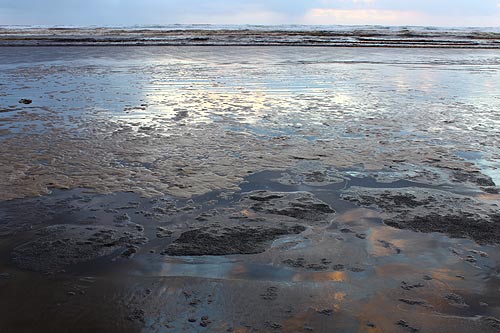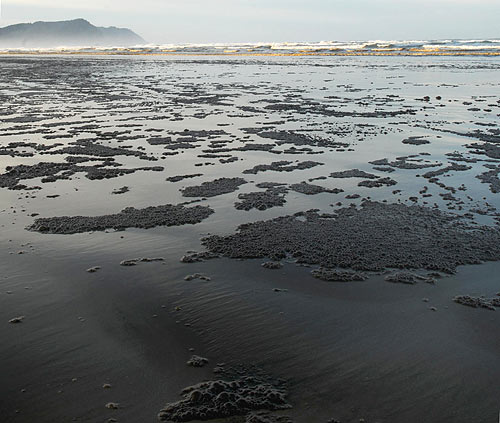 |
Odd Oily Waves Return to N. Oregon Coast - But It's a Good Thing
Published 03/21/2014

(Seaside, Oregon) – They're baaaack on the north Oregon coast.
“They” are the masses of teeny, tiny diatoms that bloom so big they make the ocean look oily and brown in Seaside.
Those gooey, funky brown waves happened again this week in Seaside, signaling the start of a season of unusual sights that often alarm visitors. It looks like an oil spill, or some other environmental disaster, but it's actually the sign of a very healthy ocean.
 |
| Diatoms under a microscope - photo Seaside Aquarium |
Tiffany Boothe of Seaside Aquarium said these blooms of diatoms happen a lot right about now, starting in winter but really gaining steam in spring and some parts of summer.
When there is such an abundance of them, the surf gets colored.
“Diatoms are single-celled plants (phytoplankton) that are found in both fresh and salt water. They are responsible for turning the surf brown and staining the sand,” Boothe said. “They form the bottom of the food chain. Everything feeds on these in some way.”
All forms of life in the ocean eat them either directly or they gobble other creatures that eat them. Even giant whales eat diatoms, filtering them through their baleen organs.
This helps illustrate just how many of them there are. In fact, some conditions create so many diatoms and other forms of plankton that they choke off the oxygen in deeper depths, creating the infamous “dead zones” sometimes found off the central Oregon coast.
Clatsop County waters – from Seaside up to Warrenton – are especially rich in the nutrients that foster such enormous blooms of diatoms. This also helps make some spots incredibly thick with beds of sand dollars, which in turn results in a huge amount of unbroken sand dollars that wash up in northern Seaside and southern Gearhart.
“Diatoms absorb large amounts of nitrates and phosphates that are delivered into the ocean by coastal rivers, contributing to their population explosion,” Boothe said.
One of the biggest sources of this is the Columbia River and the Necanicum River.
Also of note: the tiny, microscopic skeletons of these critters are partially responsible for the sea foam that is present on beaches. Air that creates bubbles through these skeletons – in the form of foam – is the other main element.
Photos below by Tiffany Boothe of Seaside Aquarium. More on Seaside at the Seaside, Oregon Virtual Tour, Map.



More About Oregon Coast hotels, lodging.....
More About Oregon Coast Restaurants, Dining.....
LATEST Related Oregon Coast Articles
Oregon Coast, Valley and Likely Washington Coast to Get Some Aurora Borealis ... |
Secrets of the Season |
Unusual Travel Articles TravelParanormal.com allows you to submit your own creepy tale or debunk one - or see up-to-the-minute news headlines about travel and the paranormal. News Headlines from All Over Oregon Need to scan Oregon headlines? Constantly updated news from all over Oregon: a comprehensive, up-to-the-minute display of news headlines from a variety of media Oregon Coast Oceanfront Lodging, Hotels, Rentals |
Back to Oregon Coast
Contact Advertise on BeachConnection.net
All Content, unless otherwise attributed, copyright BeachConnection.net Unauthorized use or publication is not permitted







































